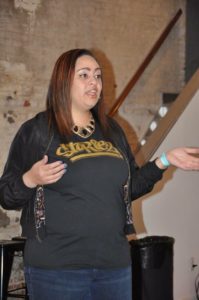This social worker is using creative storytelling to help her young clients deal with trauma
 December 27, 2016
Category: Feature, Featured, Medium, People
December 27, 2016
Category: Feature, Featured, Medium, People
Healing from trauma via personal narrative is a hot topic, but Dr. Meagan Corrado noticed a glaring disconnect in the literature.
Corrado places the genesis of her own approach, now called Storiez, between finishing her master’s degree in social services at Bryn Mawr College in 2009 and launching her doctorate degree in social work degree at Penn, which she completed this year.
“The literature and the training I was going to was saying, ‘The trauma narrative is so important,’ but it didn’t actually say in detail what a trauma narrative could look like,” Corrado said. “You’re talking about this in theory, but then when you’re sitting down working with the client, what does this look like?”
Corrado was interested in creative ways to cope with trauma because of painful experiences in her own childhood, alongside her tendency to care for family members’ emotional needs.
Fast forward to her degree programs, and “every paper I did was about trauma, but also looking at how we can creatively express the past, in light of the things we’ve been going through,” she said. “Where does that leave us?”
“Trauma, by nature, impacts your view of yourself, your view of the world around you, [and] your view of the future,” said Corrado, who works as a therapist in Philadelphia and Camden. People who have suffered trauma may have scattered memories, scattered perceptions of their experiences and a tough time imagining the future. They also may share a difficulty in trusting others, including clinicians, because of what they’ve been through.
How does Storiez work? This is how Corrado explains it to her young clients:
“A lot of the time, the things that we’ve been through make it difficult for us to concentrate and focus on the present, and give us a hard time looking toward our future, and by telling our story we can look through positive and negative things from the past.”
To do this, she uses “creative timelines.” She begins by encouraging her clients to put positive and negative memories onto different notecards, and then physically arrange the memory notecards in chronological order. From there, it’s a process (in clinical therapy sessions, taking up to three months) of detailing the thoughts, feelings and experiences associated with the memories.
Corrado is an artist herself, and her approach is flexible: Clients can express and explore these memories in a variety of ways, including writing, speaking, collage, drawing, photography, dance and video.
The end result is a newly organized and personally accessible life story, and a new sense of agency for the future.
Though Corrado’s work in narrative approaches to trauma focuses on inner-city youth — who often have little access to these kinds of resources — it can be adapted for many settings and age groups, including with a new DIY guide for service providers.
“The narrative project is really exciting to me, because it allows the person to decide their story for themselves — to organize and process the things that they’ve been through, using their own words in their own way,” she said. “And it helps them figure out how to change their story for the future.”
The Storiez process, currently in the transcription and analysis phase of a research study at Penn to help determine its therapeutic possibilities, was much more difficult to develop than it might seem.
“It’s way harder to say things simply than it is to say them in a long-winded clinical way,” Corrado said. She “went through a lot of red pens” in the pursuit of that apparent simplicity for Storiez.
Her advice for other practitioners or clinicians seeking effective new coping methods for trauma?
“Learn and speak the language of your clients,” she said. “Whether that’s inner-city youth, whether that’s people living in vulnerable areas, across cultures, learn what their language is and learn how they communicate best … and use it however you can.”
Project
StoriezTrending News










